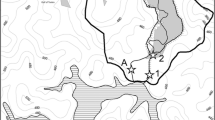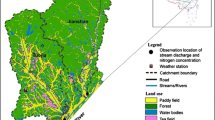Abstract
Purpose
Rice-paddy-dominated watersheds in eastern China are intensively cultivated, and lands with two crops receive as much as 550–600 kg ha–1 year–1 of nitrogen (N), mainly through the addition of N-based fertilizers. However, stream N concentrations have been found to be relatively low. Waterways in the watersheds are assumed to be effective “sinks” for N, minimizing its downstream movement. We directly measured net sediment denitrification rates in three types of waterways (ponds, streams/rivers, and a reservoir) and determined the key factors that control net sediment denitrification. Such information is essential for evaluating the impact of the agricultural N cycle on the quality of surface water.
Materials and methods
The pond–stream–reservoir continuum was sampled every 2 months at nine sites in an agricultural watershed between November 2010 and December 2011. Net sediment N2 fluxes/net sediment denitrification rates were determined by membrane inlet mass spectrometry and the N2/Ar technique. A suite of parameters known to influence denitrification were also measured.
Results and discussion
Net denitrification rates ranged between 28.2 ± 18.2 and 674.3 ± 314.5 μmol N2–N m–2 h–1 for the streams, 23.7 ± 23.9 and 121.2 ± 38.7 μmol N2–N m–2 h–1 for the ponds, and 41.8 ± 17.7 and 239.3 ± 49.8 μmol N2–N m–2 h–1 for the reservoir. The mean net denitrification rate of the stream sites (173.2 ± 248.4 μmol N2–N m–2 h–1) was significantly higher (p < 0.001) than that of the pond sites (48.3 ± 44.5 μmol N2–N m–2 h–1), and the three types of waterways all had significantly higher (p < 0.01) mean net denitrification rates in summer than in other seasons. Linear regression and linear mixed effect model analysis showed that nitrate (NO3 −–N) concentration in surface water was the primary controlling factor for net sediment denitrification, followed by water temperature. Using monitoring data on NO3 −–N concentrations and temperature of the surface water of waterways and an established linear mixed effect model, total N removed through net sediment denitrification in the pond–stream–reservoir continuum was estimated at 46.8 ± 24.0 t year–1 from July 2007 to June 2009, which was comparable with earlier estimates based on the mass balance method (34.3 ± 12.7 t year–1), and accounted for 83.4 % of the total aquatic N. However, the total aquatic N was only 4.4 % of the total N input to the watershed, and thus most of the surplus N in the watershed was likely to be either denitrified or stored in soil.
Conclusions
High doses of N in a rice-paddy-dominated watershed did not lead to high stream N concentrations due to limited input of N into waterways and the high efficiency of waterways in removing N through denitrification.





Similar content being viewed by others
References
Alexander RB, Smith RA, Schwarz GE (2000) Effect of stream channel size on the delivery of nitrogen to the Gulf of Mexico. Nature 403(6771):758–761
Birgand F, Skaggs RW, Chescheir GM, Gilliam JW (2007) Nitrogen removal in streams of agricultural catchments—a literature review. Critical Rev Environ Sci Technol 37:381–487
Burgin AJ, Groffman PM, Lewis DN (2010) Factors regulating denitrification in a riparian wetland. Soil Sci Soc Amer J 74:1826–1833
Cabrita MT, Brotas V (2000) Seasonal variation in denitrification and dissolved nitrogen fluxes in intertidal sediments of the Tagus estuary, Portugal. Mar Ecol Prog Ser 202:51–65
Colt J (1984) Computation of dissolved gas concentrations in water as functions of temperature, salinity, and pressure. Amer Fish Soc Symp Spec Pub 14
Cornwell JC, Kemp WM, Kana TM (1999) Denitrification in coastal ecosystems: environmental controls and aspects of spatial and temporal scale. Aquatic Ecol 33:41–54
David MB, Gentry LE, Kovacic DA, Smith KM (1997) Nitrogen balance in and export from an agricultural watershed. J Environ Qual 26:1038–1048
David MB, Wall LG, Royer TV, Tank JL (2006) Denitrification and the nitrogen budget of a reservoir in an agricultural landscape. Ecol Appl 16:2177–2190
Eyre BD, Rysgaard S, Dalsgaard T, Christensen PB (2004) Reply to comment on "Comparison of isotope pairing and N−2:Ar methods for measuring sediment denitrification". Estuaries 27:177–178
Findlay SEG, Mulholland PJ, Hamilton SK, Tank JL, Bernot MJ, Burgin AJ, Crenshaw CL, Dodds WK, Grimm NB, McDowell WH, Potter JD, Sobota DJ (2010) Cross-stream comparison of substrate-specific denitrification potential. Biogeochemistry 104:381–392
Garcia-Ruiz R, Pattinson SN, Whitton BA (1998) Kinetic parameters of denitrification in a river continuum. Appl Environ Microbiol 64:2533–2538
Groffman PM, Altabet MA, Bohlke JK, Butterbach-Bahl K, David MB, Firestone MK, Giblin AE, Kana TM, Nielsen LP, Voytek MA (2006) Methods for measuring denitrification: diverse approaches to a difficult problem. Ecol Appl 16:2091–2122
Groffman P, Butterbach-Bahl K, Fulweiler R, Gold A, Morse J, Stander E, Tague C, Tonitto C, Vidon P (2009) Challenges to incorporating spatially and temporally explicit phenomena (hotspots and hot moments) in denitrification models. Biogeochemistry 93:49–77
Harrison JA, Maranger RJ, Alexander RB, Giblin AE, Jacinthe PA, Mayorga E, Seitzinger SP, Sobota DJ, Wollheim WM (2009) The regional and global significance of nitrogen removal in lakes and reservoirs. Biogeochemistry 93:143–157
Harrison MD, Groffman PM, Mayer PM, Kaushal SS, Newcomer TA (2011) Denitrification in alluvial wetlands in an urban landscape. J Environ Qual 40:634–646
Herrman KS, Bouchard V, Moore RH (2008) Factors affecting denitrification in agricultural headwater streams in Northeast Ohio, USA. Hydrobiologia 598:305–314
Horner-Devine MC, Martiny AC (2008) Biogeochemistry—news about nitrogen. Science 320(5877):757–758
Inwood SE, Tank JL, Bernot MJ (2007) Factors controlling sediment denitrification in midwestern streams of varying land use. Microb Ecol 53:247–258
Jenkins MC, Kemp WM (1984) The coupling of nitrification and denitrification in two estuarine sediments. Limnol Oceanogr 29:609–619
Kana TM, Darkangelo C, Hunt MD, Oldham JB, Bennett GE, Cornwell JC (1994) Membrane inlet mass-spectrometer for rapid high-precision determination of N−2, O−2, and Ar in environmental water samples. Anal Chem 66:4166–4170
Kana TM, Sullivan MB, Cornwell JC, Groszkowski KM (1998) Denitrification in estuarine sediments determined by membrane inlet mass spectrometry. Limnol Oceanogr 43:334–339
Kana TM, Weiss DL (2004) Comment on “Comparison of isotope pairing and N2/Ar methods for measured sediments” by B.D. Eyre, S. Rysaard, T. Dalsgaard, and P. Bondo Christensen. 2002. Estuaries 25:1077–1087. Estuaries 27:157–160
Kimura SD, Yan XY, Hatano R, Hayakawa A, Kohyama K, Ti CP, Deng MH, Hojito M, Itahashi S, Kuramochi K, Cai ZC, Saito M (2012) Influence of agricultural activity on nitrogen budget in Chinese and Japanese watersheds. Pedosphere 22:137–151
Laursen AE, Seitzinger SP (2002) Measurement of denitrification in rivers: an integrated, whole reach approach. Hydrobiology 485:67–81
Li FY, Yang R, Ti CP, Lang M, Kimura SD, Yan XY (2010) Denitrification characteristics of pond sediments in a Chinese agricultural watershed. Soil Sci Plant Nutr 56:66–71
Makoto T, Itahashi S, Saito M (2005) A water quality analysis system to evaluate the impact of agricultural activities on N outflow in river basins in Japan. Sci China Series C: Life Sci 48:100–109
McCutchan JH, Saunders JF, Pribyl AL, Lewis WM (2003) Open-channel estimation of denitrification. Limnol Oceanogr Methods 1:74–81
Mulder A, Vandegraaf AA, Robertson LA, Kuenen JG (1995) Anaerobic ammonium oxidation discovered in a denitrifying fluidized-bed reactor. FEMS Microbiol Ecol 16:177–183
Mulholland PJ, Helton AM, Poole GC, Hall RO, Hamilton SK, Peterson BJ, Tank JL, Ashkenas LR, Cooper LW, Dahm CN, Dodds WK, Findlay SEG, Gregory SV, Grimm NB, Johnson SL, McDowell WH, Meyer JL, Valett HM, Webster JR, Arango CP, Beaulieu JJ, Bernot MJ, Burgin AJ, Crenshaw CL, Johnson LT, Niederlehner BR, O’Brien JM, Potter JD, Sheibley RW, Sobota DJ, Thomas SM (2008) Stream denitrification across biomes and its response to anthropogenic nitrate loading. Nature 452:202–205
Paul EA (2007) Soil microbiology, ecology, and biochemistry, 3rd edn. Academic Press, Amsterdam
Peterson BJ, Wollheim WM, Mulholland PJ, Webster JR, Meyer JL, Tank JL, Marti E, Bowden WB, Valett HM, Hershey AE, McDowell WH, Dodds WK, Hamilton SK, Gregory S, Morrall DD (2001) Control of nitrogen export from watersheds by headwater streams. Science 292(5514):86–90
Piña-Ochoa E, Álvarez-Cobelas M (2006) Denitrification in aquatic environments: a cross-system analysis. Biogeochemistry 81:111–130
Qin B, Xu P, Wu Q, Luo L, Zhang Y (2007) Environmental issues of Lake Taihu, China. Hydrobiologia 581:3–14
Quan WM, Shen XQ, Han JT, Chen YJ (2005) Analysis and assessment on eutrophication status and developing trend in Changjiang Estuary and adjacent sea. Mar Environ Sci 24:13–16 (in Chinese)
Risgaard-Petersen N (2003) Coupled nitrification–denitrification in autotrophic and heterotrophic estuarine sediments: on the influence of benthic microalgae. Limnol Oceanogr 48:93–105
Royer TV, Tank JL, David MB (2004) Transport and fate of nitrate in headwater agricultural streams in Illinois. J Environ Qual 33:1296–1304
Rudolph J, Frenzel P, Pfennig N (1991) Acetylene inhibition technique underestimates insitu denitrification rates in intact cores of fresh-water sediment. FEMS Microbiol Ecol 85:101–106
Saunders DL, Kalff J (2001) Denitrification rates in the sediments of Lake Memphremagog, Canada–USA. Water Res 35:1897–1904
Seitzinger S, Harrison JA, Böhlke JK, Bouwman AF, Lowrance R, Peterson B, Tobias C, Drecht GV (2006) Denitrification across landscapes and waterscapes: a synthesis. Ecol Appl 16:2064–2090
Seitzinger SP (1988) Denitrification in fresh-water and coastal marine ecosystems—ecological and geochemical significance. Limnol Oceanogr 33:702–724
Seitzinger SP, Nielsen LP, Caffrey J, Christensen PB (1993) Denitrification measurements in aquatic sediments: a comparison of three methods. Biogeochemistry 23:147–167
Smith LK, Voytek MA, Bohlke JK, Harvey JW (2006) Denitrification in nitrate-rich streams: application of N(2):Ar and (15)N-tracer methods in intact cores. Ecol Appl 16:2191–2207
Veraart AJ, Bruijne WJJ, Klein JJM, Peeters ETHM, Scheffer M (2011) Effects of aquatic vegetation type on denitrification. Biogeochemistry 104:267–274
Wall LG, Tank JL, Royer TV, Bernot MJ (2005) Spatial and temporal variability in sediment denitrification within an agriculturally influenced reservoir. Biogeochemistry 76:85–111
Wang S, Zhu G, Peng Y, Jetten MSM, Yin C (2012) Anammox bacterial abundance, activity, and contribution in riparian sediments of the Pearl River estuary. Environ Sci Technol 46:8834–8842
Whalen SC, Alperin MJ, Nie Y, Fischer EN (2008) Denitrification in the mainstem Neuse River and tributaries, USA. Fundamental Appl Limnol 171:249–261
Wu J-X, Cheng X, Xiao H-S, Wang H, Yang L-Z, Ellis EC (2009) Agricultural landscape change in China’s Yangtze Delta, 1942–2002: a case study. Agric Ecosyst Environ 129:523–533
Xing GX, Cao YC, Shi SL, Sun GQ, Du LJ, Zhu JG (2002) Denitrification in underground saturated soil in a rice paddy region. Soil Biol Biochem 34:1593–1598
Xing GX, Zhu ZL (2002) Regional nitrogen budgets for China and its major watersheds. Biogeochemistry 57:405–427
Yan X, Cai Z, Yang R, Ti C, Xia Y, Li F, Wang J, Ma A (2011) Nitrogen budget and riverine nitrogen output in a rice paddy dominated agricultural watershed in eastern China. Biogeochemistry 106:489–501
Zhong XY, Yang HS, Zhao LQ, Han JD (1999) Study on dynamic of N and P in the Changjiang estuary (in Chinese). J Fish Sci China 6:6–9
Zhu ZL, Sun B, Yang LZ, Zhang LX (2005) Policy and countermeasures to control non-point pollution of agriculture in China. Agriculture 23:47–51, in Chinese
Acknowledgments
This work was financially supported by the Knowledge Innovation Program of the Chinese Academy of Science (No. KZCX2-YW-GJ01) and the Natural Science Foundation of China (No. 41071196 and 41061140515). This is contribution number 4723 from the University of Maryland Center for Environmental Science.
Author information
Authors and Affiliations
Corresponding author
Additional information
Responsible editor: Brian Kronvang
Rights and permissions
About this article
Cite this article
Li, X., Xia, Y., Li, Y. et al. Sediment denitrification in waterways in a rice-paddy-dominated watershed in eastern China. J Soils Sediments 13, 783–792 (2013). https://doi.org/10.1007/s11368-013-0651-0
Received:
Accepted:
Published:
Issue Date:
DOI: https://doi.org/10.1007/s11368-013-0651-0




